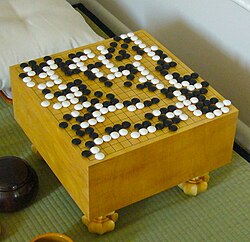Board Game Go: Board game for two players that originated in China more than 2,500 years ago
Go is a board game for two players.
It is called Wei-k'i (or Wei-chi) in Chinese, Patok or Baduk in Korean and I-go in Japanese.


Go is played on a board with black and white game pieces called stones. Players take turns placing a stone of their color on intersections of a 19x19 square grid. The player with the black stones goes first. A normal Go board has 19 rows and columns of lines. Some players use 9x9 or 13x13 boards because smaller boards usually mean shorter, less complex games.
A game of Go ends when both players pass their turns without playing. This usually happens when adding another stone to the board doesn't change the score. The winner is the player whose stones surround more empty intersections (points). To that is added captured stones and komi. Komi are points added to the second player, which in this game is the white player. A game may also end when a player gives up and resigns.
In a game against a skilled player, a less skilled player may be given a "handicap" of extra stones on the board at the start of the game as well as playing black. These rules help make the game and final score fair for both players.
Rules


Besides the order of play (Black plays first, then White plays, then Black plays, and so on) and handicap or scoring rules, there are only two rules in Go:
- Rule 1 (the rule of liberty) is that every stone remaining on the board must have at least one open "point" (an intersection, called a "liberty") next to it (up, down, left, or right), or must be part of a connected group that has at least one such open point ("liberty") next to it. Stones or groups of stones which lose their last liberty are removed from the board.
- Rule 2 (the "ko rule") is that the stones on the board must never repeat the way the stones were the turn before. Moves which would do so are forbidden, so only moves elsewhere on the board are allowed that turn. This is to prevent the game from going on forever.
Stones cannot be removed from the board except by the opponent surrounding it. A group of stones are all "alive" as long as one stone is next to an empty intersection. Stones with no liberties (no access to empty space) are captured and removed from the board. At the end of the game, the prisoners are usually deducted from the score of the player who lost them.
The second rule is called Ko (eternity). You can place stones on any clear intersection you want, as long it isn't taken off right after, or the board looks the same all over as it did before. This is to stop the game from going back and forth capturing the same stones forever. Players must make a move somewhere else on the board during a "ko fight" before they can re-capture a stone in the same position.
Its original Chinese name is "围棋" (= wei qi or wei chi). It is also popular in Japan, and its common name "Go" comes from Japanese. In Korea the game is called "baduk". In these three countries the game is an important part of the culture, like chess is in many western countries.
Go and chess are both board games and games of strategy. They both have no luck or secret information, unlike some other classic games like backgammon (dice are rolled) or poker and other card games which also have secret information.
There are many places to play Go on the Internet, as well as local clubs and national organizations in many countries around the world. A 2016 survey by the International Go Federation (IGF) found that there are over 20 million players around the world. Most players live in East Asia.
History
Go was invented in China but the specific time is not known. Some say it was invented more than 2,500 years ago and is the oldest board game still played today. The historian of board games, H.J.R. Murray, said:
Its age is often exaggerated; contemporary references to it only become frequent under the Song dynasty in China (AD 960–1279). It is significant that Chao Wu King, who lived between 970 and 1127, records how he enlarged the existing Chinese chessboard by dividing it lengthwise and across to produce a board of 19x19 points on which [the game] is now played. The game spread to Korea and Japan, where the first masters whose names has been recorded flourished between 1465–1500.
— H.J.R. Murray,
Famous players
Players active in Japan
- Go Seigen
- Eio Sakata - He holds the honorary NHK Cup.
- Kaku Takagawa
- Hideyuki Fujisawa
- Masao Sugiuchi - He used to be the oldest professional player during 2004 to 2017.
- Masao Kato - former president of the International Go Federation
- Utaro Hashimoto - founder of Kansai Ki-in, the largest Go organization in Osaka
Female players
Go to: Female Go players
Artificial intelligence
References
Other websites

- Sensei's Library, the largest Wiki about Go
- Go - Citizendium
- American Go Association
This article uses material from the Wikipedia Simple English article Go (board game), which is released under the Creative Commons Attribution-ShareAlike 3.0 license ("CC BY-SA 3.0"); additional terms may apply (view authors). Content is available under CC BY-SA 4.0 unless otherwise noted. Images, videos and audio are available under their respective licenses.
®Wikipedia is a registered trademark of the Wiki Foundation, Inc. Wiki Simple English (DUHOCTRUNGQUOC.VN) is an independent company and has no affiliation with Wiki Foundation.